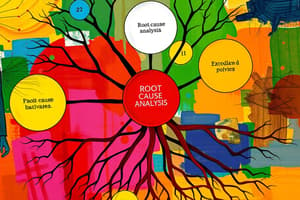Podcast
Questions and Answers
Which of the following is the primary focus of the "why, why" tool in problem-solving?
Which of the following is the primary focus of the "why, why" tool in problem-solving?
- Identifying individuals responsible for errors.
- Listing the engineering changes.
- Scheduling delivery dates.
- Describing the problem and repeatedly asking why to find the root cause. (correct)
What is the main goal of using forced field analysis?
What is the main goal of using forced field analysis?
- To strengthen promoting forces and weaken inhibiting forces related to a goal. (correct)
- To only weaken the inhibiting forces.
- To prioritize the forces from greatest to least without taking action.
- To identify all team members.
In the nominal group technique, what is the significance of assigning numerical values to ranked problems?
In the nominal group technique, what is the significance of assigning numerical values to ranked problems?
- To create a way to solve the problem creatively.
- To quantify the level of disagreement among team members.
- To provide a basis for total points, with the highest points indicating the most important problem. (correct)
- To ensure each team member agrees on which problem to solve.
What is the purpose of creating headings for each logical group within an affinity diagram?
What is the purpose of creating headings for each logical group within an affinity diagram?
When constructing an interrelationship diagram, how are cause-and-effect relationships between issues represented?
When constructing an interrelationship diagram, how are cause-and-effect relationships between issues represented?
In an interrelationship diagram, what does an issue with a high number of outgoing arrows and few incoming arrows typically indicate?
In an interrelationship diagram, what does an issue with a high number of outgoing arrows and few incoming arrows typically indicate?
What is the primary purpose of a tree diagram?
What is the primary purpose of a tree diagram?
In the context of matrix diagrams, what is the primary function of Quality Function Deployment (QFD)?
In the context of matrix diagrams, what is the primary function of Quality Function Deployment (QFD)?
What is the primary reason for using a Process Decision Program Chart (PDPC)?
What is the primary reason for using a Process Decision Program Chart (PDPC)?
In a PDPC, what does placing an 'O' underneath a countermeasure indicate?
In a PDPC, what does placing an 'O' underneath a countermeasure indicate?
What is the purpose of the Activity Network Diagram?
What is the purpose of the Activity Network Diagram?
In an activity network diagram, how is the critical path determined?
In an activity network diagram, how is the critical path determined?
What term is described as the longest cumulative time of connecting activities?
What term is described as the longest cumulative time of connecting activities?
What is one of the benefits of using an activity network diagram?
What is one of the benefits of using an activity network diagram?
Which of the following tools relies on subjective information rather than hard data?
Which of the following tools relies on subjective information rather than hard data?
Flashcards
Why, Why Technique
Why, Why Technique
A technique to find the root cause of a problem by asking 'why' repeatedly, focusing on the process rather than people.
Forced Field Analysis
Forced Field Analysis
A method to identify forces that influence a problem or goal, categorizing them as promoting (driving) or restraining (inhibiting).
Nominal Group Technique
Nominal Group Technique
A structured approach to get issue/idea input from everyone on a team, ensuring effective decisions through ranked voting.
Affinity Diagram
Affinity Diagram
Signup and view all the flashcards
Interrelationship Diagram
Interrelationship Diagram
Signup and view all the flashcards
Tree Diagram
Tree Diagram
Signup and view all the flashcards
Matrix Diagram
Matrix Diagram
Signup and view all the flashcards
Prioritization Matrix
Prioritization Matrix
Signup and view all the flashcards
Process Decision Program Chart (PDPC)
Process Decision Program Chart (PDPC)
Signup and view all the flashcards
Activity Network Diagram
Activity Network Diagram
Signup and view all the flashcards
Study Notes
- Statistical process control (SPC) tools are effective for problem-solving, but not in all situations.
- Some tools are beneficial for teams and individuals and rely on subjective information rather than hard data.
- The first three tools of the seven management and planning tools are simple, while the other 7 are more complicated.
- Application of these tools has been proven useful in process improvement, cost reduction, policy deployment, and new-product development.
- Using quality improvement tools during innovation results in higher quality, lower costs, and shorter lead times.
- The tools are useful in conceptualization and idea generation using a structured approach to problem-solving
Why, Why Tool
- A simple but effective tool for finding the root cause of a problem.
- Focuses on the process rather than people.
- Describe the problem in specific terms and ask "why" multiple times.
- Helpful in developing critical thinking and quick problem-solving.
Forced Field Analysis
- Used to identify forces and factors influencing a problem or goal.
- Helps understand promoting/driving and restraining/inhibiting forces.
- Positives are reinforced, and negatives reduced/eliminated.
- Steps include define objective, determine evaluation criteria, brainstorm forces, prioritize forces, and take action.
Nominal Group Technique
- Provides for issue/idea input from everyone on the team which results in effective decisions.
- Each team member writes the most important problem on a piece of paper.
- The problems are collected and listed on a flip chart.
- Each member ranks the problems from least to most important using numerical values.
- Points are totaled, and the item with the highest number of points is considered most important.
Affinity Diagram
- Allows teams to creatively generate and group issues/ideas logically for problem understanding and breakthrough solutions.
- State the issue in a full sentence.
- Brainstorm using short sentences on self-adhesive notes.
- Post the notes for the team to see.
- Sort ideas into logical groups.
- Create concise descriptive headings for each group.
- Large groups should be divided into smaller groups with appropriate headings.
- Stand-alone notes can become headers or be placed in a miscellaneous category.
- This encourages team creativity, breaks down barriers, facilitates breakthroughs, and stimulates ownership of the process.
Interrelationship Diagram (ID)
- It clarifies the interrelationship of many factors of a complex situation.
- The team can classify the cause-and-effect relationships among all the factors.
- The key drivers and outcomes can be used to solve the problem.
- The team should agree on the issue or problem statement.
- Ideas/issues from other techniques/brainstorming should be laid out in a circle.
- Start with the first issue and evaluate cause-and-effect relationship with the next issue.
- For example, "Lack of Respect for Others” (A), compared to "Lack of Awareness of Impact” (B).
- Determine which of these two options is stronger
- The issue that is stronger is given the arrow.
- The entire diagram should be reviewed and revised where necessary.
- Seek external opinions for up and downstream processes
Tree Diagram
- A broad objective is reduced to increasing levels of detail to achieve the objective.
- Choose an action-oriented objective statement from the interrelationship diagram, affinity diagram, brainstorming, team mission statement, etc.
- Then brainstorm to choose the major headings.
- Generate the next level by asking, "What needs to be addressed to achieve the objective?"
- Repeat the question at each level.
- Three levels below the objective are sufficient for the diagram and assignments.
- The diagram should be reviewed to see if actions give the anticipated results or if something is missing.
- The diagram encourages creative thinking, makes large projects manageable, and generates a problem-solving atmosphere.
Matrix Diagram
- Teams identify, analyze, and rate the relationship among two or more variables.
- Data are given in table form and can be objective or subjective, and can have symbols or numerical values.
- Quality function deployment (QFD) is an example of the use of a matrix diagram.
- There are 5 standard formats: L-shaped, T-shaped, Y-shaped, C-shaped, and X-shaped, with L-shaped being the most common.
- Select the factors affecting a successful plan.
- Select the appropriate format, which is the L-shaped diagram.
- Determine the relationship symbols and create a legend.
- Complete the matrix by analyzing each cell and inserting the appropriate symbol.
- The matrix diagram shows the relationship of the two variables and encourages thinking in terms of relationships, strength, and patterns.
Prioritization Matrices
- Tools prioritize issues, tasks, characteristics, etc., based on weighted criteria using tree and matrix diagram techniques.
- Prioritization allows for effective decisions by reducing options before implementation planning.
- Utilizes a combination of tree and matrix diagrams.
- There are 15 implementation options
- Construct an L-shaped matrix combining the options with the criteria.
- Determine implementation criteria using the nominal group technique (NGT) or any other technique that will satisfactorily weight the criteria.
- Prioritize the criteria using NGT.
- Each team member weights the criteria so the total weight equals 1.00.
- Using NGT, rank the options in terms of importance by each criterion, averaging the results.
- Compute the option importance score and the options with the highest total ones should be implemented first.
Process Decision Program Chart (PDPC)
- Avoids surprises and identifies possible countermeasures for achieving objectives.
- The team states the objective, such as planning a successful conference.
- Followed by the first level, which is the main conference activities.
- Determine what could go wrong with the conference as the "what if" level.
- Brainstorm countermeasures and place them in a balloon in the last level.
- Evaluate the countermeasures and select the optimal ones by marking an O underneath.
- Reject bad options by marking an X under them
- Use when the task is new/unique, complex, or potential failure has great risks.
- This provides the mechanism to effectively minimize uncertainty in an implementation plan.
Activity Network Diagram
- Also known as program evaluation and review technique (PERT), critical path method (CPM), arrow diagram, and activity on node (AON).
- Allows teams to schedule a project efficiently
- Highlights completion times, simultaneous tasks, and critical activity paths.
- Brainstorm or document all the tasks.
- These tasks are recorded on self-adhesive notes so all members can see them.
- The first task is located and placed on the extreme left of a large view work surface.
- Tasks that can be done simultaneously are placed below.
- Number each task and draw connecting arrows.
- Determine and post the task completion time in the lower left box.
- Recorded completion times in hours, days, or weeks.
- Determine the critical path by completing the four remaining boxes in each task.
- The boxes are used for the earliest start time (ES), earliest finish (EF), latest start (LS), and latest finish (LF).
- Benefits include (1) a realistic timetable determined by the users, (2) team members understanding their role in the overall plan, (3) bottlenecks discovered and corrected, and (4) members focus on critical tasks.
Summary
- The first three tools can be used to resolve situations and are beneficial
- The last seven tools are called as the seven management and planning tools which can be used individually or as a solution
- The team can also create customize the sequence based on their needs
Studying That Suits You
Use AI to generate personalized quizzes and flashcards to suit your learning preferences.




